Club Night Report
Wednesday 9th August 2023
Club Night Photos for Wednesday 9th August 2023 - Club Demonstrator: Arthur Kingdon
The demonstrator for the August 2023 meeting was a welcome return of Arthur Kingdon (The Society of Ornamental Turners), whose previous evening presentation to the Club was in January 2013 - where he showed some work produced on an early version of a home-made Rose Engine.Arthur's demonstrations for the evening were a mix of PowerPoint presentation/ explanation/ examples and the history of Ornamental Turning and Rose Engine work, along with some live cutting of examples of the 'patterns' and processes used to produce them on a Rose Engine. He also brought along a table-full of examples of work he had made and some of the intricate and specialised equipment and cutters used on his machines.
Arthur started his presentation with a couple of definitions to explain the differences between: "Ornamental Turning, also called Complex Turning, is executed on a lathe with attachments which convert a plain circular section to variants of outline; these range from a simple series of cuts taken at intervals around the work (so producing grooves or bumps on the surface) to non-circular movements whereby the whole of the circular shape is removed to give a completely different form." And the activities that most of our Club Members are engaged in, called: "Plain Turning is work executed on a lathe where a transverse section through any part of the work comprises a plain circle"
This was followed with examples of work and machines from C1539 to the present day. The machinery included examples of exotic antique machines but also machinery that was home made, low cost, and requiring little to no engineering skills.
Arthur brought along his own Rose Engine that he had made a couple of years ago using half-a-sheet of MDF, a Myford spindle bought on eBay for £10 and a few other metal parts.
The plans for the MDF Rose Engine are available online. See: https://www.rogueturner.com/mdf-rose-engine.html
The material used for ornamental turning is usually timber that is hard, close grained and dense, such as lignum vitae, African blackwood or box wood. The material should be very plain as any figuring would detract from both the ornamenting and the beauty of the figuring.
For this demonstration, he was using lemon wood that had been sprayed black in order to show the cuts as they were produced.
The first part of the demonstration covered ornamental turning created by indexing and, as a rose engine headstock is designed to rock, Arthur started the demonstration by securing the headstock to emulate a fixed head lathe. He started with 'indexing' and used a 'cutting frame' driving a single point tool to produce a 'basketwork' pattern on the outside of a cylinder. Three rows/ revolutions were cut and a 'half-index' was used to generate the basket pattern.
Arthur next showed the use of a 'pearling drill' - which is a shaped (end) drill type of cutter - to cut 30 pearls in the end face of the workpiece - using the indexer and a belt-driven drilling spindle.
The next piece of equipment used was an eccentric cutting frame - with a rotating single point cutter to generate a number of overlapping, circular cuts in the end face, also utilising the indexer.
For the second part of the demonstration, the headstock was unlocked and was free to rock. The rocking is controlled by shaped rosettes fixed to the spindle and these press against a guide (AKA a rubber or follower). Rotating the spindle using the hand crank causes the headstock to rock from side to side. The first rosette used had fifteen equal bumps and this was used to create the same basketwork pattern that had been demonstrated earlier by indexing. This was now a much faster process and removed any possibility of the errors that can occur when indexing.
The next workpiece was held in a 4-jaw chuck and an elliptical rosette and a router driven carbide cutter was used to generate a smooth elliptical shape on the end of the piece. A second rosette and rubber were then combined to generate a stepped pattern on opposite sides of the ellipse.
Arthur's final demonstration piece was to hold an African blackwood blank in an ER32 collet mounted in the spindle. The rosette was changed and an independently motor-driven cutter was used to create a 'Tudor rose' pattern on the end face of the piece - via a combination of the headstock rocking motion controlled by the rosette and the piece rotation from the hand crank.
Arthur entertained and educated us in a wide ranging, fast moving, demonstration of ornamental turning/ Rose Engine techniques. Perusing the examples on Arthur's display tables (see below) illustrated that he had only shown a small fraction of the potential of these machines.
For Club Members who had not previously been exposed to these types of machines, setups and tooling it was a true 'eye-opener'.
An interesting, informative and often mystifying (just how did he do that?) evening of a truly different branch of turning - that has the ability to produce spectacular and stunning results!
Thank you, Arthur!
 |
 |
 |
 |
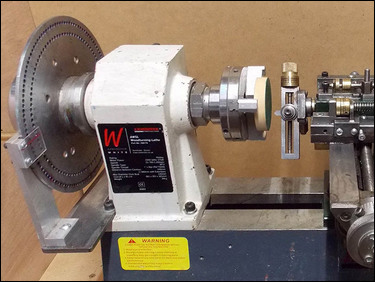 |
 |
 |
 |
 |
 |
 |
 |
 |
 |
 |
 |

|
 |
 |
 |
 |
 |
 |
 |
 |
 |
 |
 |
 |
 |
 |
 |
 |
 |
 |
 |
The Display Tables were very well supported with a wide range of interesting items.
Paul Kohn showed a bird house and a couple of prototype finials intended for staircase newel posts. Bob Wells presented an ash pot and an olive ash platter. Martin Barrett showed a burr oak hollow form, with two options for the finial, along with a London plane platter and Richard Branscombe displayed a crotch bowl made in spalted birch. Harry Rock showed two sets of apples and pears made in birch plywood - cut at different angles to achieve different patterns in the grain. Arthur Kingdon populated two tables with examples of his work. Martin Stanway had several fine pens on the table - which, unfortunately were not photographed…
 |
 |
 |
 |
 |
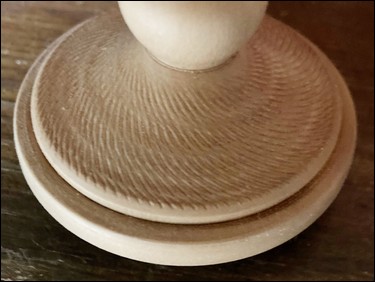 |
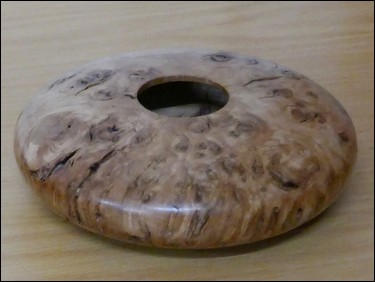 |
 |
 |
 |
| Here are some photos from the display tables and an image from his workshop that Arthur presented as examples of his work: |
|
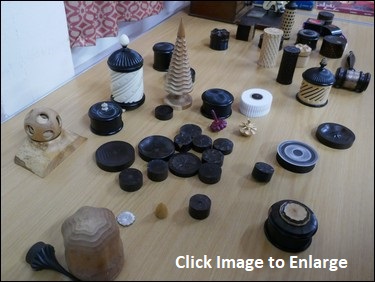 |
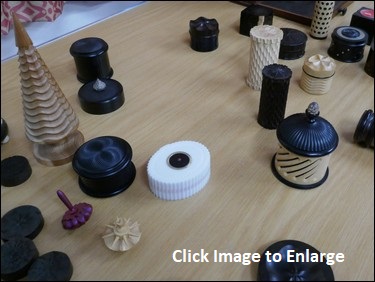 |
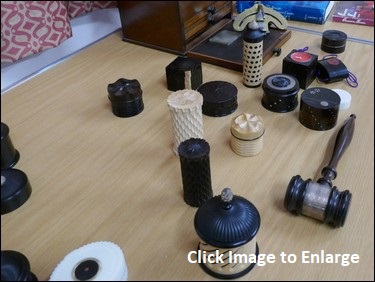 |
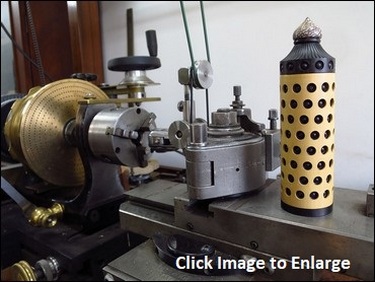 |
